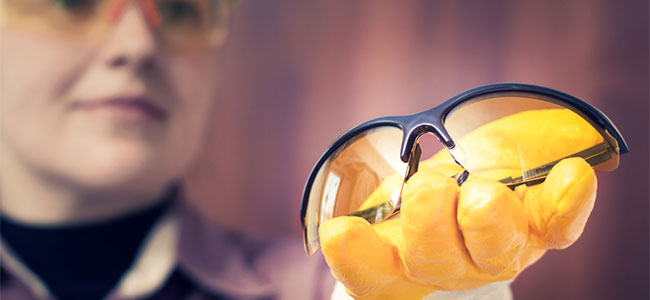
Vision: A Key Piece in the Safety Puzzle
Employers sometimes lose focus on vision protection when handling high-fatality dangers such as falls. Fortunately vision protection might be having its big moment.
- By Shane Foreman
- Sep 06, 2023
Safety in the industrial workplace has not been on the firmest footing in recent years. Factors such as COVID workplace restrictions, economically-induced consolidation of workforces, and a feeling that companies need to “catch up” for lost time have made the workplace environment fraught with accidents, some of them even fatal.
Jack Dennerlin, adjunct professor of ergonomics and safety at Harvard’s Department of Environmental Health and co-director of Work Health and Well-being: Achieving Worker Health at the Harvard T.H. Chan School of Public Health had this to say, “COVID-19 has stressed the system. All the flaws that have been in place are totally exposed and have come to the forefront of our daily conversations.” No, the pandemic hasn’t caused every safety ailment, but it did have a lasting ripple effect.
The Big Player in Safety Incidents
According to the Bureau of Labor and Statistics, there were 5,190 fatal work injuries recorded in the United States in 2021, and falls, slips, and trips in construction and extraction occupations accounted for 370 of these fatalities in 2021. Legal Jobs, a legal watchdog organization, says on their website that 36.5 percent of all deaths in the workplace occur as a result of employees falling.
While not all falls are fatal, they also top the list for non-fatal workplace accidents. According to the Centers for Disease Control, 18 percent of the 1,176,340 non-fatal work injuries in 2020 were related to slips, trips and falls.
These statistics rightly put an emphasis on preventing falls. According to the OSHA website section on fall protocol, “workplaces must provide fall protection at elevations of four feet in general industry workplaces, five feet in shipyards, six feet in the construction industry, and eight feet in long shoring operation.”
As a result, many companies implement physical fall protections and PPE, and adopt safe work practices and training to prevent serious falls.
But falls aren’t the only issue in the workplace. One overlooked area of bodily protection is right under our nose, or above our nose…as is the case: our eyes. Though eyewear has come a long way in the past 50 years, universal adoption rates are far from perfect. Most manufacturing and construction industries require their employees to wear protective eyewear, but studies show that is not always enforced.
Further, employees may be given eyewear that is poor-fitting or that doesn’t account for harsh environments like heat and steam. RX Safety cites discomfort, poor fit, and lens fogging as the primary reasons workers remove their glasses during the workday: “Wearing ill-fitting and uncomfortable safety glasses or goggles for 40+ hours per week can cause many workers to forgo use of their glasses or to wear them intermittently. Lens fogging in goggles is another problem that not only produces discomfort, but interferes with vision.”
Why do workers will pick productivity over their own safety? A study by Jonathan Cohen and Samuel McClure at Princeton; David Laibson at Harvard; and George Loewenstein at Carnegie Mellon, titled “Brain Battles Itself Over Short-term Rewards, Long-term Goals”, found that “We have different neural systems for different problems, and our behavior arises from their competition or cooperation.” Often, people choose the immediate option (paycheck) even if risking a long-term loss (eye injury).
This phenomenon is unsustainable because the stakes are too high. Common eye injuries such as chemical burns, retinal abrasions and eye loss make workplace eye protection compulsory.
Vision Protection’s Big Moment
Personal protective eyewear makers had a real moment during COVID: They were quick to meet the demand for eyewear that kept out most airborne particles and gave employees a sense of psychological safety. That is not to be discounted.
Today’s employee needs safety glasses to meet intense and often varying work environments to combat lens fogging and scratching. Fortunately, advancements in technology have made these properties attainable. Some companies even offer prescription-ready lenses or “RX accommodation” for larger goggles.
In recent years, eyewear manufacturers have developed close relationships with the companies that use them and brought key stakeholders into the R&D process early. This has spurred innovations such as designs that incorporate nuances like face shape, bridge of the nose, cheekbone height and brow construction to create universal seal capability. Also, technologies that provide greater clarity and acuity are poised to meet the demands of the 21st-century workforce. They are adjusting to how comfort impacts employees’ eyewear use during the workday.
And employers are demanding better eyewear. They understand the high cost of not having the right eyewear for their employees: According to the National Safety Council, an eye injury costs $26,568 on average in workers’ compensation nationally. So, PPE that protects workers’ eyes protects the bottom line.
The companies leading eyewear safety of tomorrow will adapt to the needs of the evolving market. Eyewear that can perform in the areas of technology, fit and prescriptive clarity will be most poised to meet the demands of this dynamic workforce.
»
This article originally appeared in the September 2023 issue of Occupational Health & Safety.